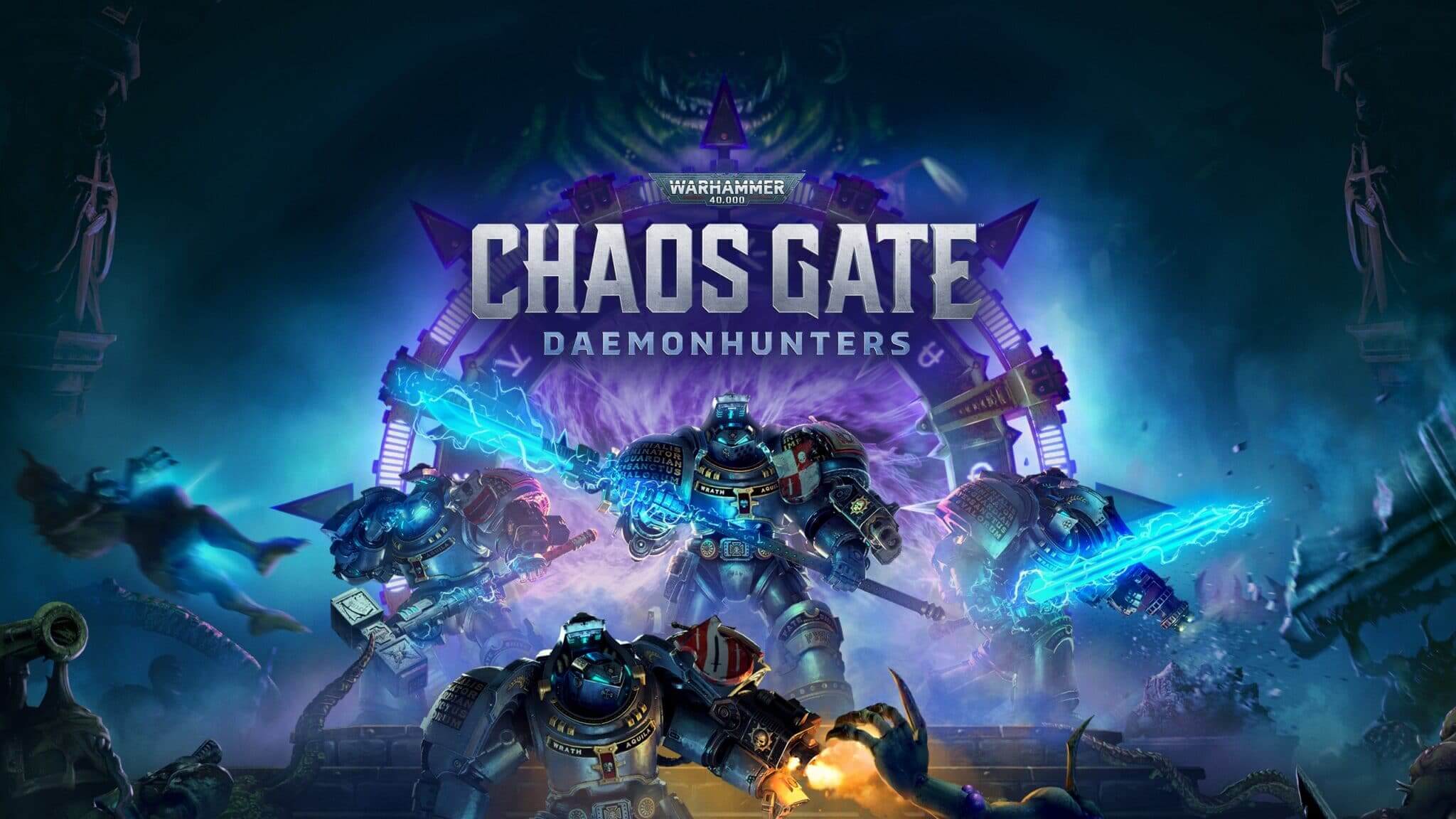Set in the grim distant future, Warhammer 40K: Chaos Gate – Daemonhunters by Complex Games requires you to take command of a group of Grey Knights – elite warriors trying to stop a Chaos God’s plague; fighting the daemonic servants in tactical turn-based combat.
Overview
The game is mission-driven. The main goal is to hunt down servants of Nurgle, Chaos God of Disease, plotting to create a terrible plague. You command Grey Knights – special forces, whose task is guarding the Imperium from the Chaos Gods and their daemons. Your current objective is given by an inquisitor, who detects the threat and orders your ship to eliminate it.
However, your ship is in disrepair and the warriors aren’t as strong as usual. The tutorial explains that they were returning home after a long and bloody campaign. In it, the commander and all the more experienced Grey Knights died fighting the God of Blood; the ship itself suffered heavy damage.
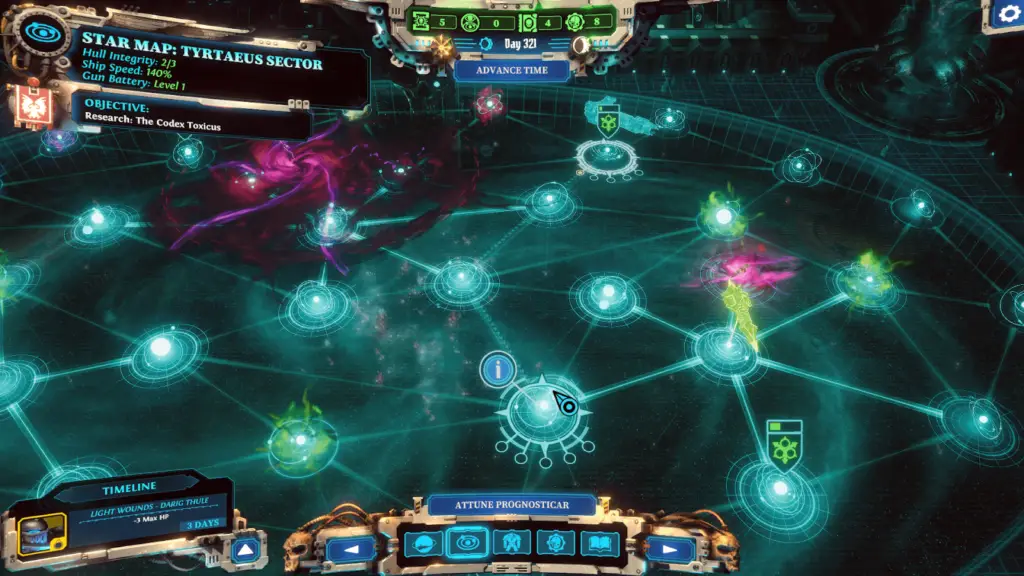
The overall gameplay consists of two sections. The first is the strategic layer. There, you have access to a map of systems, the knights, the ship, and the research screen; you can also have short conversations with your subordinates and the inquisitor. Next is the tactical layer, where you engage in turn-based battles vs. various servants of Nurgle.
On the map, the game uses a real-time-with-pause system. You can either let the time pass or maneuver your ship around. There are also two main decisions for you to make: where to go, and where to place your prognosticars. The latter are a resource, giving bonuses in the system you place them in; plus the other systems that connect to the same node. If you spend enough resources researching prognosticar bonuses they can become pretty impactful.
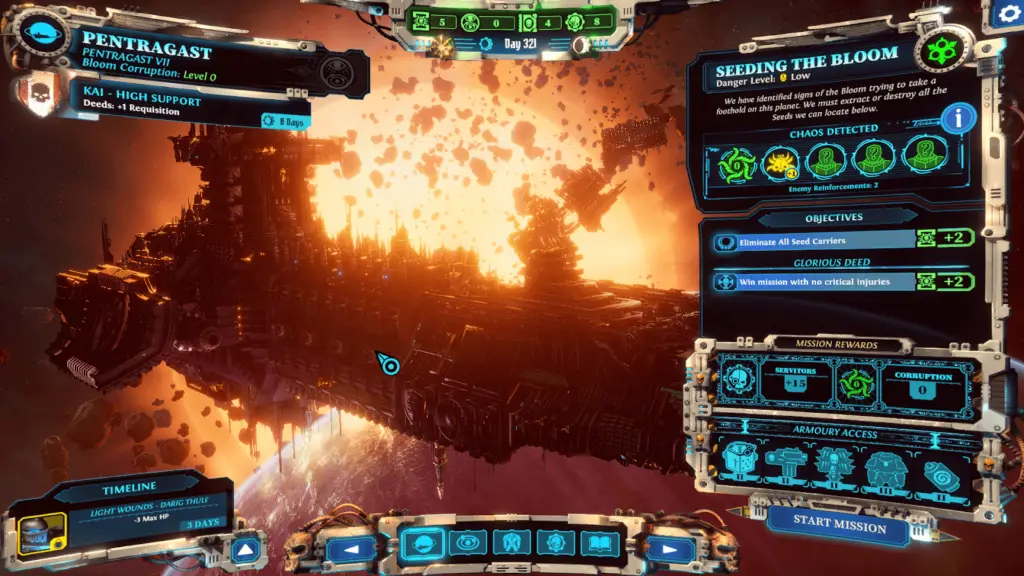
Missions will periodically pop up on the map. These usually have a timer before they disappear; you can maybe complete just one or two before they expire. Each offers different rewards. Those include a combination of one reward you gain automatically, and some additional ones. The latter you can purchase with a limited resource, called requisition points. You will also get a bonus objective. Completing it gives you more requisition points.
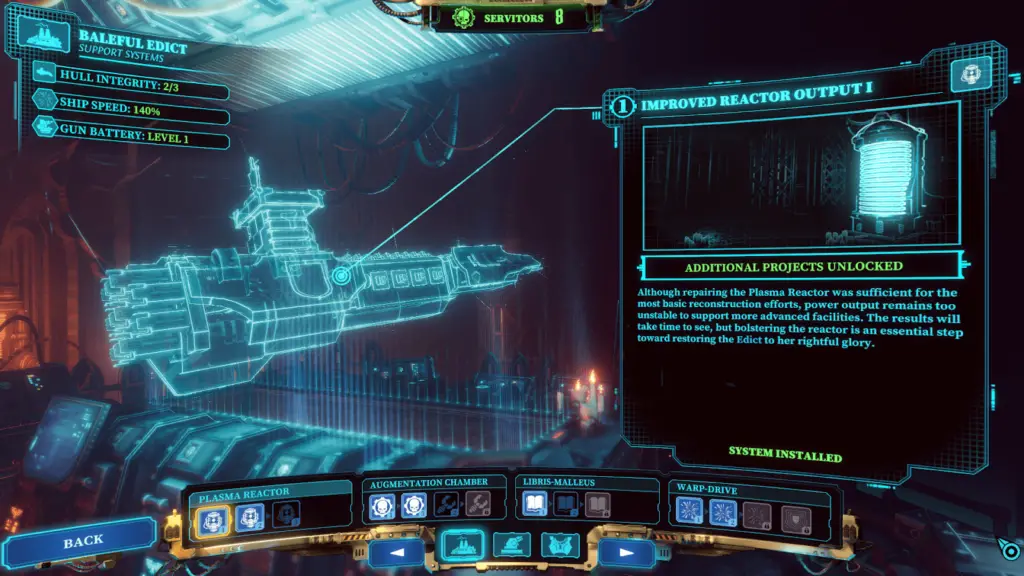
Your ship repairs are fairly simple, with a clear value proposition for most. They give a variety of bonuses: increasing speed, unit healing, and experience gain; providing resources – servitors for building up the ship, and prognosticars; or improving the ship’s structural capabilities – mostly relevant for special events.
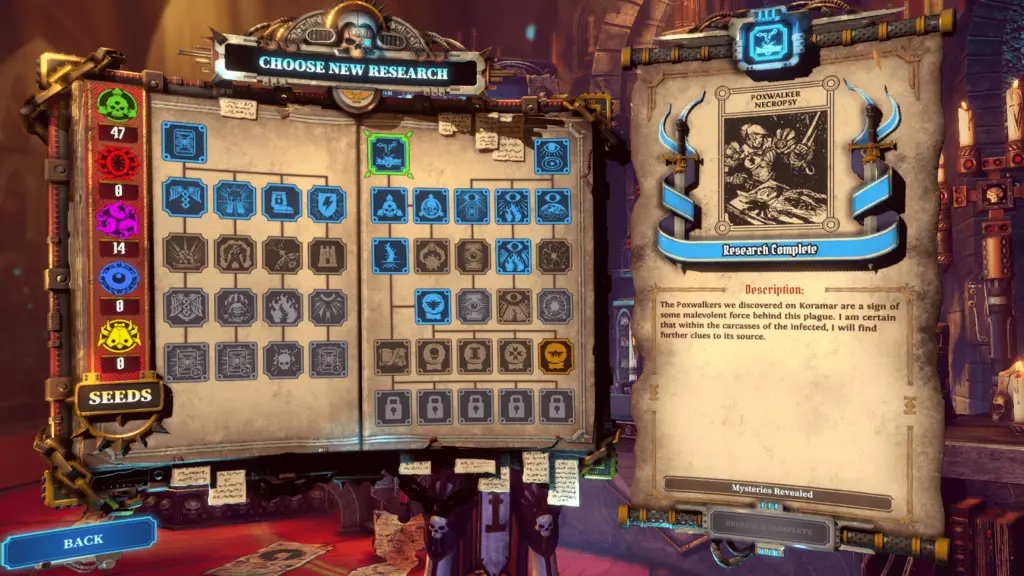
Research requires a combination of time and another limited resource. The latter’s called seeds, and is also used for gear upgrades. Research subjects include: ways of managing strategy cards, which can be used in battle; prognosticars’ improvements; decreasing gear upgrade costs; and advancing the story.
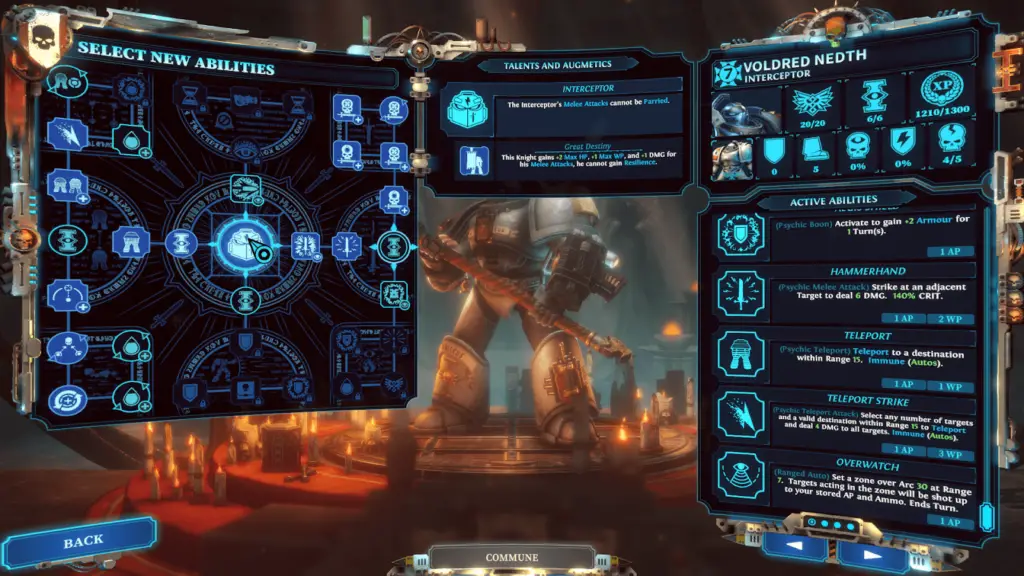
Managing knights involves choosing their gear and abilities. At first, you can recruit characters from just four different classes; more become available later. Each class has its own skill tree featuring 36 options. Characters get two skill points per level. Since you can only pick half of the options, you can have fairly different builds, even for the same class. However, the latter also defines what items you can equip. There are seven melee weapons, five ranged, and two armor types. All are unique, and the various combinations can have a strong impact on the character’s capabilities. The system isn’t about picking the highest numbers – there are real choices to make.
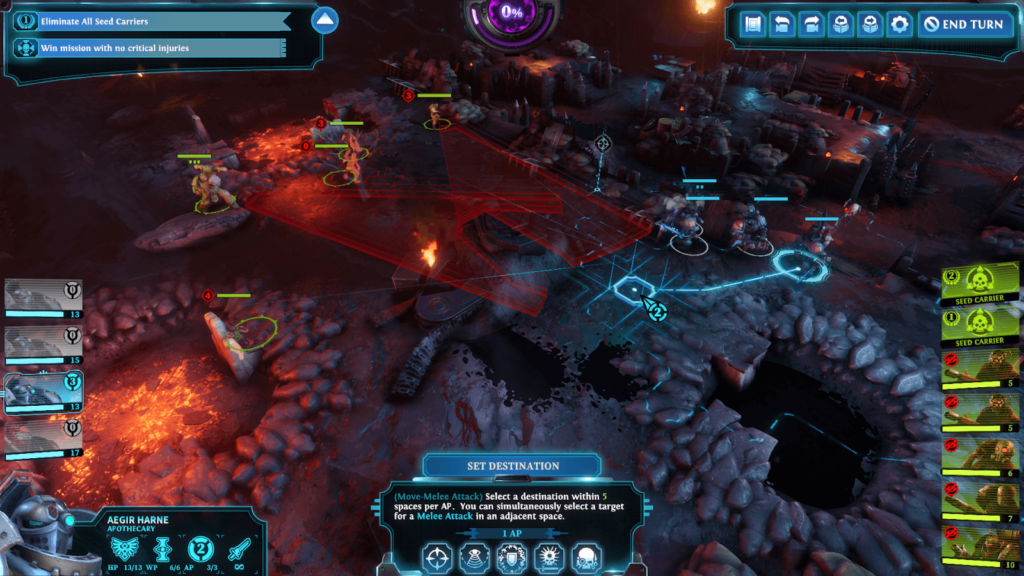
Missions tend to involve either hunting down enemies or traveling to a location and defending it. The characters all take turns using their three action points traversing the wasteland – trying to accomplish the stage’s specific goals. Battles are turn-based and are strongly reminiscent of those in XCOM 2. Although with many flourishes and upgrades, unique to this game. The combat uses a you-go-they-go system. So – you move all your units, your opponents move all their units; this continues until the battle is over. Between combat, you can move around the stage. When an encounter begins – or ends – the individual action points are restored.
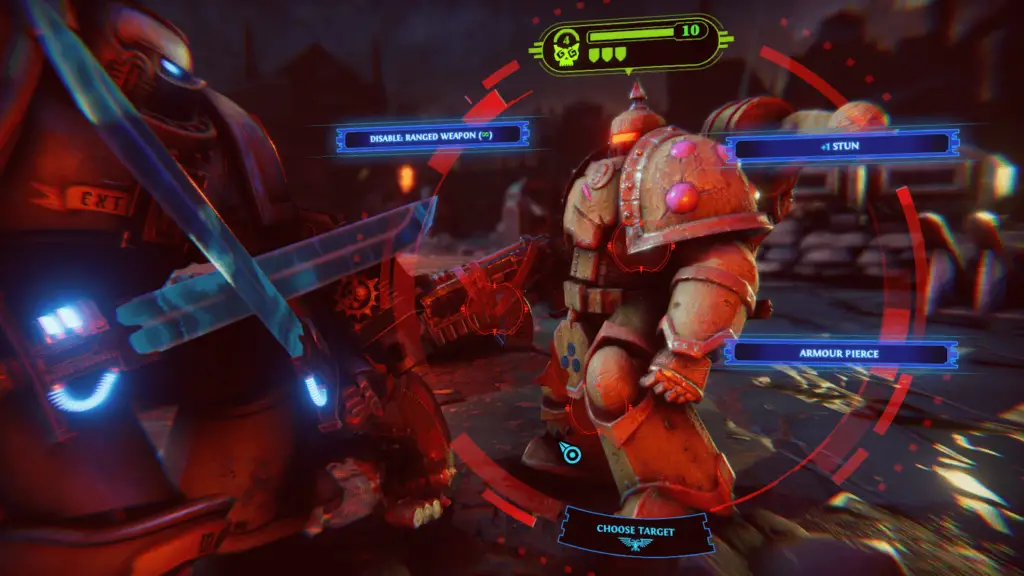
Each character has three action points. They can use those to move, attack, or perform one of their class or weapon special abilities. The latter depend on willpower – which increases through the class tree or gear; killing enemies restores it. There are no hit rolls – cover and excessive range instead reduce your damage. There are critical hit chances, however. When a crit occurs, you get bonus damage – and can either apply a permanent debuff or use a one-time attack bonus.
Enemies start off as simple mooks with guns, or zombies – and get increasingly more horrifying and weird as the game progresses. There are a few boss-level foes with unique capabilities. Those provide a change of pace and new challenges that you wouldn’t see in the more normal stages.
Achievements and Triumphs
Warhammer 40K: Chaos Gate – Daemonhunters does a lot of stuff right. The UI is great at showing most everything you want to know. The art and the overall graphics are on point, with a nice mix of ominous, cool, and silly – which fits the Warhammer 40K style. Plus, the game’s systems are well-thought-out.
Environments are interactive and fun. Often there are bits of terrain you can attack for additional effects – and if you see oil on the ground, be sure fire effects will make it burn. Similarly, your grenades and explosive attacks can cause cascading effects, destroying terrain and potentially reshaping the battlefield in interesting ways. And, if you push someone off into an endless pit, they really won’t come back. All of this makes battles tactical and engaging.
Character building too is well-done. There are tons of abilities, and considering the overall tree’s structure, the choices do result in interesting combinations. Unfortunately, some characters have fairly obvious builds. However, in those cases there may be better abilities hidden in less interesting trees. Isn’t ideal, but does make you think about what you select.
Combat feels dynamic, which could be a direct result of the three action point system enabling a variety of strategies. Among those are hit-and-run tactics; aggressive posturing; and ridiculous stunts – as you run across the battlefield to throw a grenade at a group of enemies who decided to gather around some explosive terrain. The impression becomes even stronger during boss fights, which require fun and innovative strategies.
The story is tense and well-written, for the most part. There is one particular stratagem that comes a bit later in the game that doesn’t seem too thought-out. Still, other than that, the narrative is great, with characters making logical decisions, based on their personality.
Failures and Weaknesses
Although Warhammer 40K: Chaos Gate features solid design, there are places where it fails to cut to the heart of what makes turn-based tactics fun. The first issue is the stage and goal variety. Except for boss fights, you are mostly hunting enemies at a specific spot, or going to a specific spot to defend some location. The search and destroy missions have three slight variations and the defensive ones have one; of those you’ll mostly see two search and destroy versions. Adding to this is the low enemy variety; not a problem in of itself if the situations in which you encounter them are different. However, combine it with a lack of stage and goal variations, and it’s a recipe for boredom.
A different gameplay structure could fix this. Unique enemy combinations could require new and interesting tactics. Instead, you eliminate most enemies before they can do anything. One class, the Interceptor, can close large distances with almost no effort, stack bonus action points from crits, and neutralize most threats. In combination with some other classes, it can deal with almost any challenge. Granted, the first few times you do this feel great.
But after, there’s no need to learn new strategies. Even when there are more enemies than you can defeat in one round, you can handle anything even remotely threatening and get in a defensive position. This becomes less of an issue as you climb difficulties, requiring a bit more caution when approaching enemies. But even this gets very repetitive, very quickly.
Conclusion
Warhammer 40K: Chaos Gate – Daemonhunters has a lot going for it; clearly the developers have a ton of love for both 40K and turn-based tactics. This makes the lack of variety and some egregiously broken classes surprising. That’s not to say the game isn’t worth playing, but if you have any doubts, you might want to wait and see if they do something to fix these flaws.


